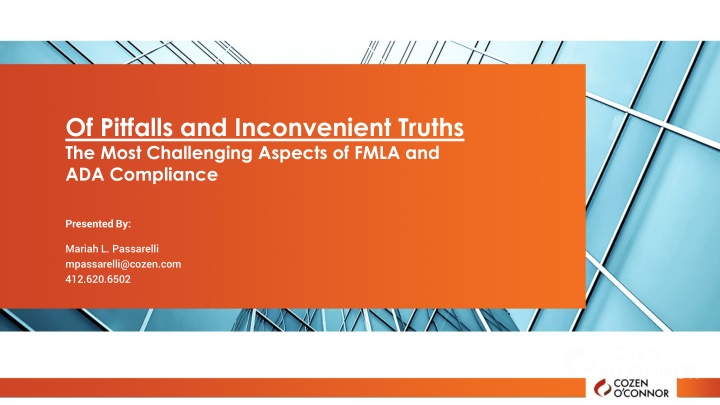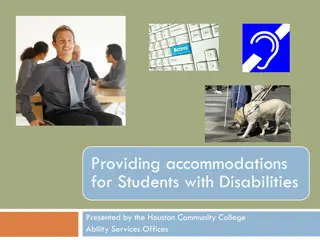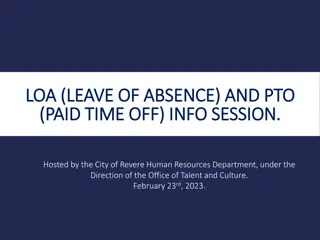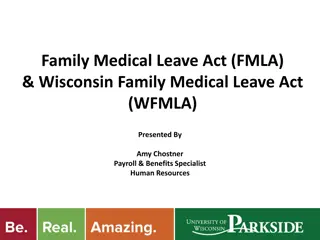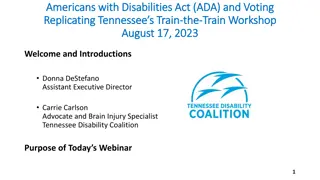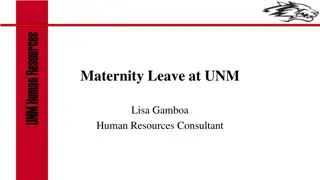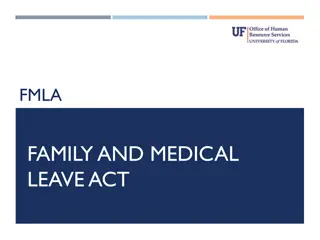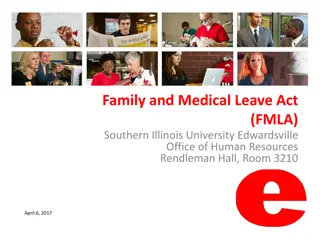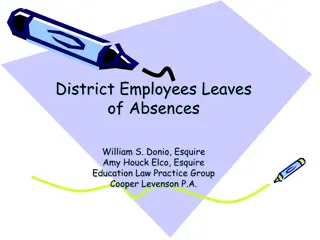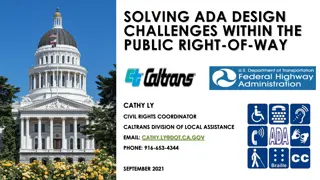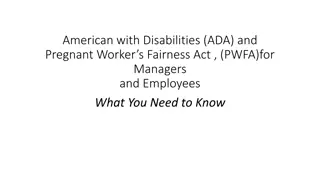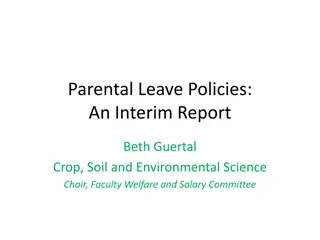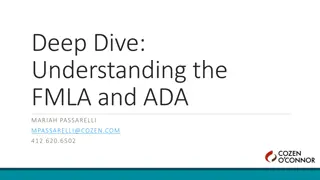Navigating FMLA and ADA Compliance Challenges
The Americans with Disabilities Act (ADA) and the Family Medical Leave Act (FMLA) continue to pose challenges for employers. This presentation covers complex aspects of FMLA and ADA compliance, such as handling ADA leave after FMLA, job transfers as ADA accommodations, and issues in remote and hybrid work settings. Learn about the employee thresholds, basic provisions of FMLA, types of FMLA leave, and eligibility criteria to ensure compliance and smooth navigation of these important regulations.
Download Presentation

Please find below an Image/Link to download the presentation.
The content on the website is provided AS IS for your information and personal use only. It may not be sold, licensed, or shared on other websites without obtaining consent from the author.If you encounter any issues during the download, it is possible that the publisher has removed the file from their server.
You are allowed to download the files provided on this website for personal or commercial use, subject to the condition that they are used lawfully. All files are the property of their respective owners.
The content on the website is provided AS IS for your information and personal use only. It may not be sold, licensed, or shared on other websites without obtaining consent from the author.
E N D
Presentation Transcript
Of Pitfalls and Inconvenient Truths The Most Challenging Aspects of FMLA and ADA Compliance Presented By: Mariah L. Passarelli mpassarelli@cozen.com 412.620.6502
The gifts that keep on giving The Americans with Disabilities Act ( ADA ) was enacted in 1990 (significantly expanded in a related Amendments Act in 2009) The Family Medical Leave Act ( FMLA ) was enacted in 1993 30+ years later, compliance with the ADA and FMLA continues to present challenges for employers In this presentation we will discuss the most difficult to navigate aspects of FMLA and ADA compliance, including the treatment of ADA leave following a period of FMLA leave, job transfer as an ADA accommodation, and unique issues related to remote and hybrid working environments
Can I sleep through this presentation? If your company employs more than four (4) people, no. Minimum employee threshold by Act: FMLA = 50 employees, employed within a 75-mile radius, in any given 12- month period ADA = 15 or more employees (anywhere) Pennsylvania Human Relations Act ( PHRA ) = four (4) or more employees or individual contractors (anywhere)
A quick spin through the basics: FMLA Provides unpaid, job-protected time off for qualifying employees under qualifying circumstances Prohibits employers from interfering with the right to leave Prohibits discrimination against employees who have requested and/or taken FMLA leave Prohibits retaliation against employees who have requested and/or taken FMLA leave
A quick spin through the basics: FMLA There are two types of FMLA leave: Contiguous = FMLA leave taken in blocks of continuous time; and Intermittent = FMLA leave taken in smaller increments of time (partial hours, hours, days) over the course of weeks or months Requires three things: 1. Covered employer (50+ employees in a given 12-month period) 2. Eligible employee Employee works at a location where there are 50+ employees within a 75-mile radius Employee has worked for the employer for (1) at least 12 months total, and (2) at least 1,250 hours in the immediately preceding 12- month period 3. Qualifying event
A quick spin through the basics: FMLA Qualifying events: Pregnancy/birth = 12 week block or intermittent Parental bonding = 12 weeks can be restricted to block, must be taken within 12 months of child s birth/placement, can be combined for parents Care for spouse/child*/parent with a serious health condition = 12 week block or intermittent Employee s own serious health condition = 12 week block or intermittent Military caregiver = 26 week block or intermittent Military exigency = time periods specified by statute
A quick spin through the basics: FMLA What is a serious health condition? = Illness, injury, impairment, or physical or mental condition that involves inpatient care or continuing treatment by a health care provider Continuing treatment includes treatment for chronic/permanent conditions, conditions requiring multiple treatments (course of medication counts), examination/medical tests to determine condition, treatment for substance abuse, COVID (and related quarantine period)
FMLA Pitfall #1: Elective Procedures Truly elective procedures are not covered by the FMLA (e.g., elective cosmetic surgery, elective cosmetic dental procedures, elective abortion) HOWEVER, what may seem at face value to be elective may actually be the result of medical necessity In any event, complications arising from an elective procedure may still constitute a serious medical condition Rhetorical question: How deep are you willing to dig into an employee s personal medical information to satisfy yourself that a procedure was elective just to deny FMLA? (Hint: Not very deeply) Risks associated with knowing things you cannot unknow
FMLA Pitfall #2: Leaving it up to the employee Once the Company is on notice of an FMLA-qualifying event, the FMLA must apply This means, even where an employee asks to first exhaust his/her PTO or to otherwise delay the onset of FMLA leave, the Company cannot legally permit the employee to do so Very specific, statutory deadlines exist in the FMLA that require the Company to take a series of actions after becoming on notice of an FMLA-qualifying circumstance and training of both supervisors and HR on these deadlines is important The FMLA is the only federal employment law statute of this nature that does not require any level of intent by the Company in order to constitute a violation of the law
FMLA Pitfall #3: The no-fault attendance policy You can require an employee to use PTO concurrently with FMLA You can allow employees the option of using PTO concurrent with FMLA You cannot apply any form of negative attendance impact to an employee related to their FMLA (or, for that matter, ADA) leave use After the company is on notice of a potential FMLA-qualifying event/condition, application of the attendance policy related to the absences themselves must be suspended The Company can still require the employee to follow certain call-off procedures and discipline the employee for failing to do so, but (un)common sense must be applied Don t make people on 12 weeks of FMLA call off every day Don t require anything of FMLA users that you don t apply to everyone else
FMLA Pitfall #4: Grandma needs a break The expanded definition of child under the FMLA presents a unique challenge to employers If grandma/stepdad/uncle/aunt/adult sibling is providing either day-to- day care or financial support for a child, they qualify for FMLA leave to care for that child in the event that child has a serious medical condition This does not require the child s biological parents to be out of the picture There is no standard of documentation the employer can request as evidence Here again, rhetorically: How deep are you willing to dig to establish the existence of an FMLA-qualifying relationship?
Pitfall #5: Intermittent intolerance Supervisors hate intermittent FMLA leave. Co-workers hate intermittent FMLA leave. HR hates intermittent FMLA leave. None of this matters. The majority of FMLA discrimination cases I have handled arise from supervisors/co-workers remarking/reacting negatively to an employee s intermittent FMLA leave use. Training (and actual supervision of co- workers) is needed to curtail this behavior. For the leave use itself, the Company cannot do anything to accelerate an employee s use of FMLA time Company cannot suggest alternative medical care Company cannot require an employee to go home for the day after a medical appointment Company cannot punitively change employee s work schedule to address anticipated intermittent leave use
The MOTHER of FMLA/ADA Pitfalls: The Tail When an employee is using FMLA leave for their own serious health condition, exhaustion of FMLA automatically triggers the beginning of the ADA interactive process (i.e., the FMLA/ADA Tail) Virtually all serious health conditions are also ADA-qualifying disabilities Intermittent and continuous periods of time off are available as reasonable accommodations under the ADA and must be considered Here again, the attendance policy must be suspended while the interactive process takes place (i.e., an employee who has exhausted FMLA leave cannot be disciplined/terminated for missing additional work without first determining whether the ADA may cover the absences)
A quick spin through the basics: ADA The ADA requires employers to make a reasonable accommodation for the known disability of a qualified applicant or employee Unlike the FMLA, there is no minimum months/hours worked eligibility threshold (indeed, the ADA applies at the job application stage) Qualifying disability is an extremely broad concept. It includes any physical or mental impairment that substantially limits one or more major life activity and/or major bodily function
A quick spin through the basics: ADA When an employee either (1) requests a job/schedule modification due to a physical or mental health condition, (2) reports that a physical or mental health condition is impacting their work (including attendance), or (3) the Company observes that an employee s known physical/mental health condition may be impacting their work, the Company s ADA obligations are triggered What are the obligations? (1) to engage in the ADA interactive process and (2) to provide the reasonable accommodations that are medically necessary for the employee to perform the essential functions of their job Interactive process = a back-and-forth dialogue involving the employee, the employee s health care provider, and HR (can never be the employee s immediate supervisor)
ADA Pitfall #1: Requiring fully clear duty Workers Compensation law has a concept called released to full duty. This concept does not exist in the ADA. Thus, when an employee returns from FMLA leave or any other type of time off from work, but needs job/schedule modifications in order to work, the employer must engage in the ADA interactive process to determine (a) whether the employee has an ADA-qualifying disability, and (b) if so, what accommodations are needed Outside of Workers Compensation, the employer cannot refuse to return an employee to work because the employee has not been fully cleared
ADA Pitfall #2: Essential function foul-ups An accommodation is reasonable under the ADA, as long as it does not remove an essential function of the job. There are numerous caveats to this that employers ignore at their peril: To be an essential function, the function has to be in a written job description listed as such The function has to actually be essential (i.e., part of the everyday tasks the employee must perform) The function must not be one that could easily be assumed by others working in the employee s area on the employee s shift
ADA Pitfall #3: Work from home Particularly since the COVID-19 pandemic, employers have seen a rise in ADA requests from employees seeking to work remotely A strict nobody can work from home policy is not legally defensible under the ADA Rather, the ADA requires that all requests for accommodation be considered on a fact-specific, employee-specific basis The employer must actually analyze whether (a) the employee s health care provider paperwork supports the notion that working from home is the only acceptable accommodation, and (b) if so, whether the employee can perform their essential job functions while working remotely Spoiler alert: If you made this position work from home during the pandemic, the answer to (b) is yes .
ADA Pitfall #4: Transfer as an accommodation If an employee has expressed the desire to work, but you determine that they cannot perform the essential functions of their current job with the accommodations that are needed, the next step is to consider job transfer as a reasonable accommodation. You cannot terminate the employee, put them on unpaid leave, or make them use up all their PTO in lieu of taking this step. To consider this accommodation, you must examine whether there are any vacant positions for which the employee would qualify, with or without accommodation.
ADA Pitfall #4 (cont) Employee cannot be made to go through application/interview process (though statutorily-required license testing is okay) Transfer would be permanent if condition is permanent, otherwise employee must be transferred back to original job when the need for accommodation ends Job restoration at the end of a temporary transfer is absolute (no loss in seniority, no change in shift, no reduction in compensation) Employee s pay can be lowered to match new position (but this is only a good idea if the transfer is permanent/long term) If there are multiple vacant jobs for which the employee would quality, the Company must start by offering the job that most closely resembles the employee s current position (i.e., the transfer offered cannot be punitive)
ADA Pitfall #5: Leave as an accommodation If an employee expresses that they cannot work or you have determined that the employee cannot be accommodated in their current position and there are no appropriate job transfers available, then you must consider time off as a reasonable accommodation You cannot shortcut to this step to avoid reasonable accommodations in the employee s current position. You cannot shortcut to this step to avoid undesirable job transfers. Continuous time off is considered reasonable if it is (a) definite, and (b) less than a year in anticipated duration There is no hard and fast rule with regard to intermittent time off (called modified work schedule under the ADA), but it should be pretty liberally permitted
General Traps and Truths You do not have to grant the ADA reasonable accommodation; you need only grant an accommodation that is medically sufficient Undue hardship is a unicorn it essentially never exists, don t fall for it Under the FMLA, you can temporarily transfer an employee who is using intermittent leave in order to account for provable business needs, the same is not true under the ADA Really significant modification of physical workspaces/tools is technically required by the ADA, so be careful in denying these requests Be careful not to make assumptions about an employee s physical abilities their need for accommodation must be determined through the interactive process or else it could give rise to a regarded as disability discrimination claim
New stuff: The PWFA On April 15, 2024, the EEOC issued its regulations to assist employers in carrying out the new Pregnant Workers Fairness Act ( PWFA ) Previously, pregnancy itself was not a serious health condition under the ADA, nor a qualifying disability under the ADA; as such, employers did not have a legal obligation to accommodate pregnant employees. No more. The PWFA requires employers (using the same ADA interactive process and definitions) to provide a reasonable accommodation to a qualified employee s or job applicant s known limitations related to, affected by, or arising out of pregnancy, childbirth, or related conditions Here again, be careful that you are not making assumptions related to a pregnant employee s abilities
HR Overwhelmed? Theres a new solution in town! ConnectBridge, a Third-party Administrator and ancillary business of Cozen O Connor, provides a refreshingly new approach to FMLA and ADA claims administration grounded in transparency, communication, and accuracy The ConnectBridge difference Better people No call center employees Decades of ADA/FMLA compliance experience Better training and direction Better onboarding Ready-made employee communications, quick reference cards, and instructional videos Customized employee training webinars Better technology Claims submission via computer, mobile device, or 800 number HR access to claims filed on-demand Cutting-edge, customizable analytics Better throughput built-in laws, employee communications, and company workflows Seamless integration with company HR systems In-house mail center and operations
Thank you Mariah Passarelli mpassarelli@cozen.com 412.620.6502 For more information about ConnectBridge, contact Mariah or Trevor McGuinness, Managing Director, Cozen O Connor Ancillary Businesses, 215.665.7269, tmcguinness@cozen.com
